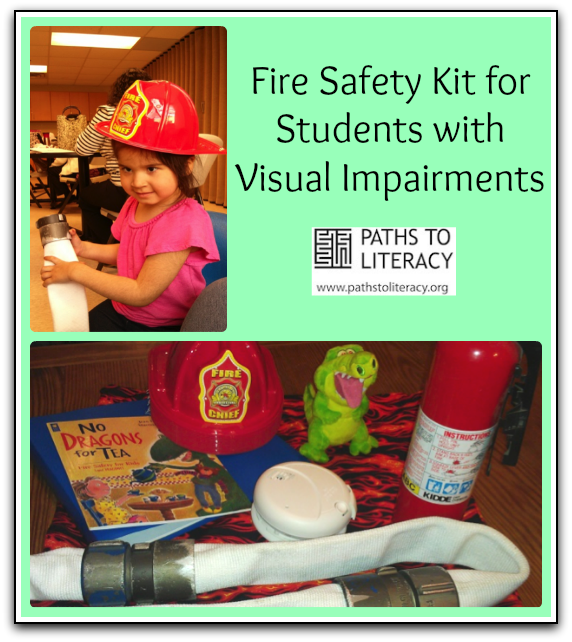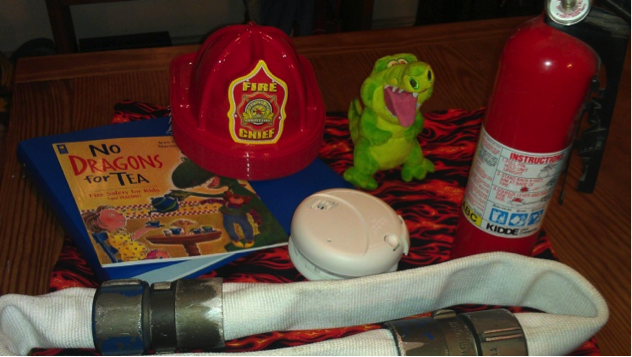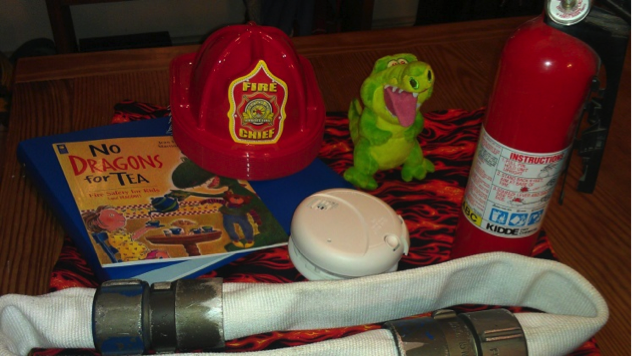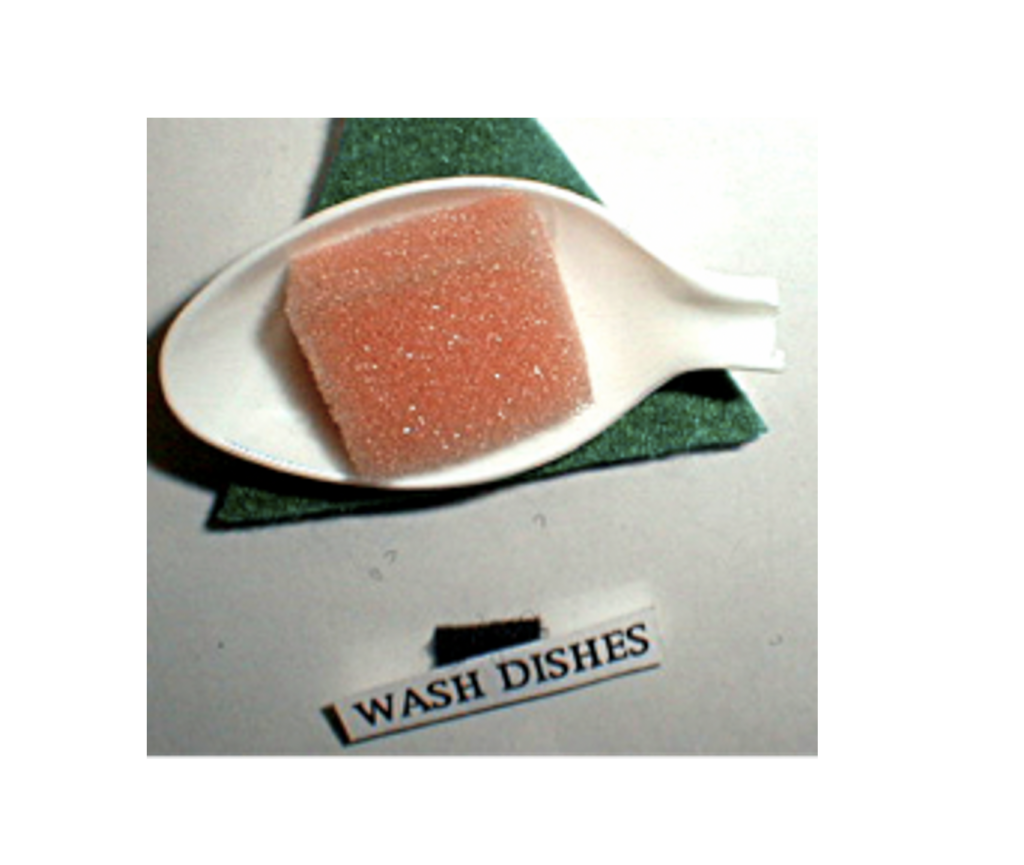This post is by Lisa Pruner and Catherine Summ.
Overview
-
For children with vision impairments, fire safety and awareness are often literally out of reach, placing them at increased risk in the event of a fire
-
Smoke detectors, fire extinguishers, and rescue equipment remain abstract concepts to kids who are blind unless they have the opportunity to explore and learn about each item in a hands-on manner.
-
By creating a fun, tactually-engaging “literacy skills kit” with readily available materials, you can develop a lesson for teaching fire safety (along with literacy and critical thinking) to young children with visual impairments in your community.
What is a literacy skills kit?
A literacy skills kit is an easily transportable kit (we use handmade bags in fabrics related to the story) containing a carefully chosen children’s book which addresses one specific skill which needs to be taught directly/differently to a child with a visual impairment. Teachers of children with visual impairments call these “Expanded Core Curriculum” (ECC) skills because they are skills which children who don’t see well need above and beyond the regular curriculum. These skills may be as obvious as braille, or less apparent, like using body language correctly or understanding the workings of a smoke detector by tactually exploring it. Literacy skills kits usually contain the book, “props” related to the story, literacy questions at different levels, a list of potential follow-up activities, and a responses journal. Kits were originally designed to be used by a parent and child, but have also been successfully used by teachers and students, as well as groups. This particular kit addresses fire safety with a fun book titled, No Dragons for Tea, as well as related props, questions, and activities.
See also our earlier post: Creating Literacy Skills Kits to Target the Expanded Core Curriculum.
How to use a literacy skills kit:
-
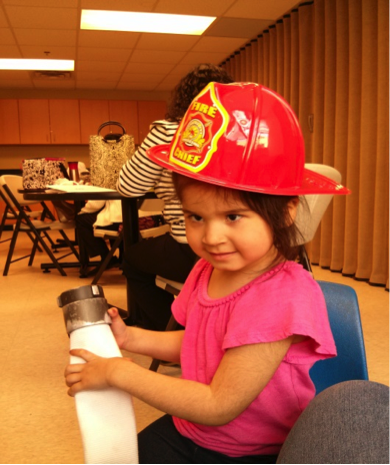 Explore the contents of the bag together to preview the topic
Explore the contents of the bag together to preview the topic - Read the story (in print of braille) together, using included manipulatives as “pictures” to illustrate the story.
- Discuss the story – What did you enjoy? Do you want to read more books like this?
- Review the literacy comprehension questions and/or create your own questions.
- Read through the list of extended literacy activities. Choose one activity – or try them all!
- Provide feedback – have the student write/draw/braille about the story or one of the activities in the reader response journal. Also note any ideas for questions or extended literacy activities that were not included in the original ideas.
- Share the kit! Make fire safety accessible for everyone!
The fire safety themed literacy skills kit should include the following items:
- Two copies of No Dragons for Tea, by Jean Pendziwol – one print and one braille. Print copies available from Barnes and Noble (BN.com)
- Eraser, available from an office supply store, www.staples.com
- Crayons, available from an office, art or school supply store
- Soft pencil case with binder ring holes, available from an office supply store, www.staples.com
- Smoke alarm, available from a hardware store, www.homedepot.com, www.amazon.com
- Batteries, available from a hardware store, grocery store, internet
- Plush dragon, available from a toy store, www.toysrus.com, www.stuffedsafari.com , www.douglascuddletoy.com
- Fire extinguisher, available from a hardware store or home improvement store,www.fireequip.com, www.homedeport.com,
- Firefighter hat, may be available from your local fire station. Also available from www.amazon.com (Rhode Island Novelty, firefighter Chief Hat Plastic Child, set of 12)
-
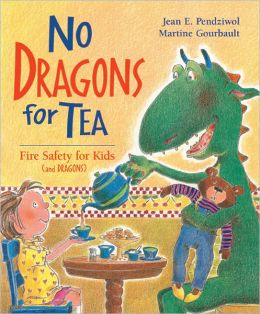 Print AND braille copies of the kit instructions
Print AND braille copies of the kit instructions -
Three ring floppy braille binder, available from American Printing House for the Blind (www.aph.org, product catalog number 1-04295-00)
- Dark lined paper, available from American Printing House for the Blind (www.aph.org, product catalog number)
- Braille paper, available from American Printing House for the Blind (www.aph.org, product catalog number)
- 20/20 pens, available from
- Dark lead pencils, available from
- Fire hose
- Plastic page inserts
How to sew a literacy skills bag (a box or pre-made bag could also be used, but using cute, related fabric really adds to the kid-appeal of the kits!):
- Select a piece of fire themed fabric that is ¾ yard long. Select a cord that is as wide as the fabric, plus an additional 10”.
- Make a pocket for the drawstring: Fold the top of the fabric down 1” and iron the fold. Fold it another inch. Iron on the fold, pin the fabric in place and sew along the bottom of the fold, creating an opening for the drawstring.
- Sew the bag: Fold the fabric widthwise, right side of the pattern together.
- Sew along the bottom of the bag and up the side, stopping before you reach the opening and closing for the drawstring. Secure your seam.
- Turn the bag right side out and insert the drawstring through the opening. Attach a safety pin to one end of the cord to draw it through.
-
Tie the cord ends together and draw the bag shut.
The following items should be stored in the pencil case:
- crayons
- eraser
- dark lead pencils
- 20/20 markers
The following items should be arranged in front to back order in the floppy 3-ring binder:
- Pencil case
- Kit instructions (print)
- Fire hose text (print)
- Kit instructions (braille)
- Fire hose text (braille)
- Dark lined paper
- Braille paper
The following items should be stored in the literacy bag:
- Reader response binder
- Print and braille copies of No Dragons for Tea
- Plush dragon
- Fire extinguisher
- Smoke detector
-
Firefighter hat
No Dragons for Tea
By Jean Pendziwol
Illustrated by Martine Gourbalt
Contents:
- Two books, notebook with writing supplies, paper, firefighter hat, smoke alarm, batteries, dragon, fire extinguisher
Literary Comprehension Questions:
- Initial Understanding – Who did the child bump into while racing down the hill in the red wagon? Where did they go after that and what did they do?
- Making a Connection – What would you do if something caught on fire at your house? Have you or anyone you know ever experienced a house fire?
- Taking a Critical Stance – Do you think it was a good idea for the dragon to hide under the rug? Why was it important for the child in the story to crawl out of the house?
Extended Literacy Activities:
- Read “The Dragon’s Fire-Safety Rhyme” at the end of the book. Read it a few times and once you are familiar with it try turning it into song. Try singing, clapping and/or playing instruments. Discuss why each of the rules in the rhyme is so important.
- Contact your local fire department to arrange a family field trip. Ask if they can show you some of the things described in the story: boots, helmets, masks, pump truck, ladders, siren, hoses, lights, passenger seats in the fire truck, etc.
- With an adult, examine the fire extinguisher included in this kit and have them explain what it does.
- Make a fire-escape plan and choose a meeting place that everyone agrees on. Conduct a practice family fire drill so that everyone is familiar with the evacuation procedure. Practice crawling along the floor.
- With your phone disconnected, practice calling 911 with an adult. Practice giving your name, address and any other information that will make it easier for firefighters to find your home. Remember, never call from inside a burning building.
- Practice how to “stop, drop and roll.” If your clothes catch fire, never run. Stretch out on the ground, cover your face with your hands, and roll from side to side to smother flames.
- Find out where your smoke detectors are and listen to what they sound like. The smoke detectors’ batteries should be changed twice a year.
- Practice what to do in different fire emergency situations. Don’t take any toys with you, and don’t stop to change your clothes. Feel closed doors before opening them. If they are hot, do not open them. Find another way out, such as a window. Learn how to remove window screens and unlock windows so that they can be used as exits in an emergency. Remember that the most important thing is to get out of the building.
- Discuss what things could be dangerous in your home. For example: matches, hot stoves, curling irons, coffee pots, fire places, etc.
Fire Hoses
There are different types of fire hoses. The lined fire hose is by far the most widely used type of hose. It consists of one or more woven-fabric seamless jackets into which a rubber tube has been inserted and vulcanized. A lined fire hose has a rubber or plastic tube within one or two protective jackets.
Fire Hose Couplings
There are three basic types of hose couplings in fire service use: Threaded couplings, sexless couplings, snap couplings. There is an example of a hose with a threaded coupling included in this kit. One of the oldest coupling designs involves the casting or machining of a spiral thread into the face of two distinctly different couplings-a male and a female. A male coupling thread is cut on the exterior surface, while a female thread is on the interior surface of a free-turning ring called a swivel. The swivel permits connecting two sections of hose without twisting the entire hose. Some manufacturers make the larger size of couplings with either ball bearings or roller bearings under the swivel to ensure their smooth operation. Unlike common pipe threads, which are relatively fine, fire hose coupling threads are course, which aids in connecting the coupling quickly. A flattened angle at the end of the thread, called the blunt start, or Higbee cut, prevents cross-threading when couplings are connected.
Modern threaded couplings have rounded rocker lugs. On the couplings, one of the rocker lugs on the swivel is scalloped with a shallow indentation, called the Higbee indicator, to mark where the Higbee cut begins. This indicator aids in matching the male coupling thread to the female coupling thread, which is not readily visible.
Connecting Hose-Two Person Method
Two people may work together to connect a hose. Each person faces the other and holds, respectively, a male and female coupling. The person with the male coupling holds the coupling with the threads outward. A second person holds the female coupling shank with the swivel outward, then aligns the female coupling with the male coupling. (It is sometimes helpful for the person holding the male coupling to look away so that only one person aligns the coupling.) With the couplings aligned, the second person turns the swivel clockwise to make the connection.
